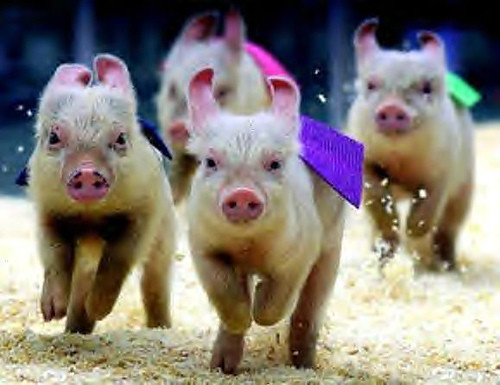
MRSA is coming! Run for your lives!
....this little piggy had MRSA up its nose. A recent study from the Netherlands found that 39% of slaughtered pigs carried MRSA. This is particularly surprising since MRSA rates in hospitals in the Netherlands are remarkably low. Even in the U.S., the commensal MRSA frequency in humans is around 1.5%. What's up with the piggies? Here's the abstract; some additional comments afterwards:
Recently methicillin resistant Staphylococcus aureus (MRSA) was isolated from pigs and pig farmers in The Netherlands. In order to assess the dissemination of MRSA in the Dutch pig population, we screened 540 pigs in 9 slaughterhouses, where a representative portion of Dutch pigs (63%) was slaughtered in 2005. We found 209 (39%) of the pigs to carry MRSA in their nares. Forty-four of 54 groups of 10 consecutive pigs (81%), each group from a different farm, and all slaughterhouses were affected. All MRSA isolates belonged to 1 clonal group, showing Multi-Locus Sequence Type 398 and closely related spa types (mainly t011, t108 and t1254). Three types of the Staphylococcal Chromosome Cassette (SCCmec) were found: III (3%), IVa (39%) and V (57%). All 44 tested isolates (1 isolate per group) were resistant to tetracycline, reflecting the high and predominant use of tetracyclines in pig husbandry. Twenty-three percent of the isolates were resistant to both erythromycin and clindamycin and 36% to kanamycin, gentamicin and tobramycin but only a single isolate was resistant to co-trimoxazole and none to ciprofloxacin and several other antibiotics. The percentage of MRSA positive pigs was significantly different among slaughterhouses and among groups within slaughterhouses, indicating a high prevalence of MRSA in pigs delivered from the farms as well as cross contamination in the slaughterhouses.
Other disconcerting things:
- 39% MRSA in a non-clinical setting is really high. If the methicillin resistance is what is actually being selected, what the hell is the selective pressure? To the best of my knowledge, we don't see that in other studies.
- Maybe methicillin resistance per se doesn't have much to do with this observation at all. It's basically one 'epidemic' clone that has spread throughout the Netherlands piggies. It would be really nice to know what the methicillin sensitive staph are up to--is it the same clone, but lacking the methicillin resistance determinant?
- This one clone appears to have acquired methicillin resistance multiple times. That seems important, but I don't know what to make of it.
Definitely not good news.
- Log in to post comments
More like this
I'm kidding, but ScienceBlogling Tara Smith has co-authored a PLoS One article about the emergence of the MRSA strain ST398 in Iowan pork farms. Pig farms are a tremendous reservoir of bacteria: as far as I can tell, there are about six pigs for every person in Iowa.
MRSA ST398 a methicillin…
Yesterday, I posted about how feral pigs might be responsible for the spinach-associated E. coli O157:H7 outbreak. A while back, I described the epidemic spread of a new strain of MRSA throughout pigs in Europe. What was puzzling to me was why this MRSA strain, found at forty to sixty-fold…
This is not good. A recent article in Emerging Infectious Diseases describes two separate cases of community-acquired ST398 MRSA--and neither case was associated with agriculture. Let me explain what this means and why this is really bad news.
MRSA--methicillin resistant Staphylococcus aureus--…
Methicillin-resistant Staphylococcus aureus (MRSA) is very difficult to kill. This notorious "superbug" can withstand a broad and growing range of antibiotics, and is the leading cause of hospital infections in many countries. But it's not restricted to hospitals. According to studies coming in…

Mike, please would you edit the subtitle of this excellent post to remove the obscenity so I can link to you? Thanks.
It's clearly the work of the "Evil Doctor Pork Chop" from the first "Toy Story" movie,
Freida
Mike,
Quit being such an Anglo Saxon.
http://en.wikipedia.org/wiki/Fucking,_Austria
For the record it sounds like we might be, Fucked, that is.
Cheers!
Must be past my bedtime I meant to address the previous post to AJ, not Mike.
Ugh. Thoughts: 1) Let's hope that M resistance is linked to something else that is under the selective pressure. 2) time to check the feed (rogue antibiotics, immunomodulators,...etc). As with fish feed, I'd bet we'd be depressingly surprised at what we'd find. 3) Your point number 3 bothers me but I'm not sure why. It should be telling us something about how this is being selected for but I'm not sure what.
Good post.
Thanks